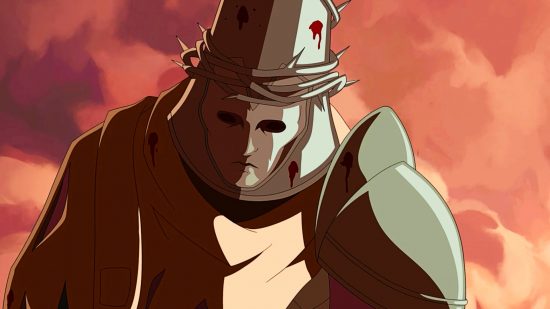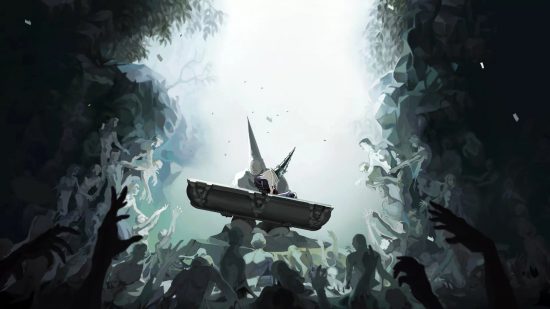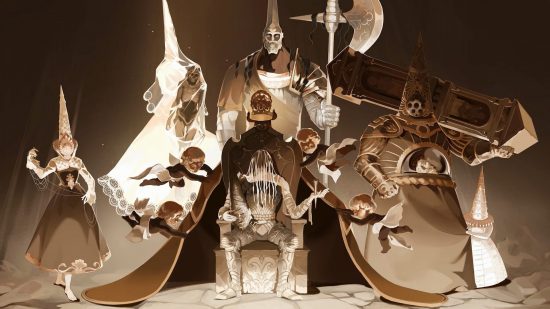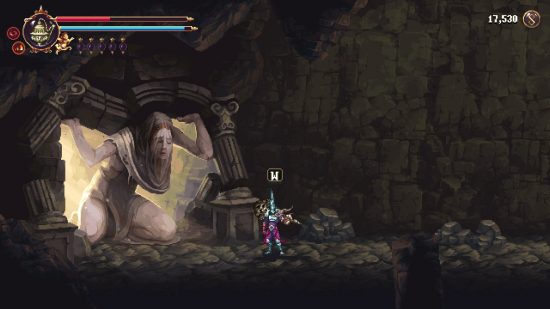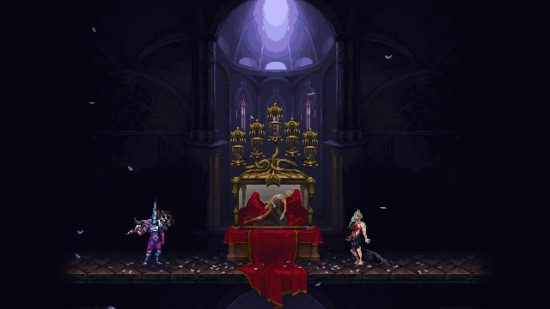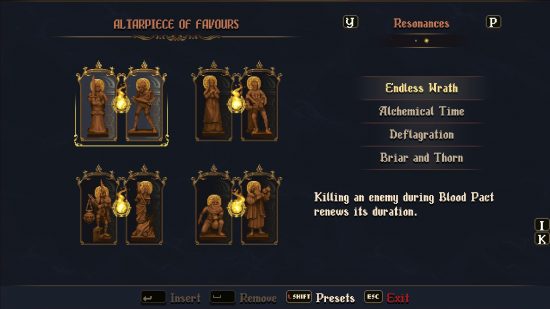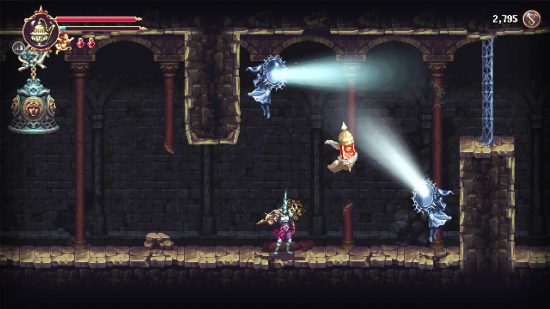Our Verdict
Blasphemous 2 is a well-constructed but ultimately conventional Metroidvania, and while it still delivers on holy grotesquerie and striking visuals, the end result is a sequel that feels markedly smaller in scope.
Rise, Penitent One – God’s up to no good again. It’s been less than two years since our last pilgrimage, but here we are again, crawling out of our sarcophagus for a second round of self-flagellation. Thankfully, Blasphemous 2 deftly avoids driving newcomers straight into the weeds of its worldbuilding with a straightforward presentation of my objective in its opening. Of course, there’s the customary miasma of soulslike exposition to go along with it, but all in all, my goal is remarkably clear-cut: reach the Christ-like Miracle Child in time to witness the birth. Blessed be the fruit of Catholic homunculi.
Our Blasphemous 2 review finds the game has been polished to a high standard, and nowhere is this more evident than in its cutscenes. These sequences are now rendered by Sunshine Animation Studio – the very same studio that produced the Wounds of Eventide DLC’s animated trailer. Each cutscene is frankly beautiful in its depiction of Cvstodia’s ornate architecture and striking characters, with silky smooth animation that brings the world to life. Nevertheless, I can’t help but find it all a little too beautiful. I’m inclined to compare the haunting brutality of some early scenes to the Mea Culpa’s creation, and I find this brave new world of Catholic horror to be strangely sanitized. This shift towards a cleaner visual style extends across the entirety of Blasphemous 2, and while it feels mean-spirited to criticize an improvement, all this polish serves to undermine the gritty and grotesque aesthetic established by Blasphemous’ crunchy pixel art.
An indeterminate amount of time may have passed since the Penitent One’s first foray through Cvstodia, but it’s not long before I cross paths with the usual suspects. I’m certainly not against popular enemies returning for a sequel; on the contrary, leaping out of the path of a charging bell-giant is the perfect reintroduction, delivering a delightful shot of nostalgia. However, as I reach new areas I become very conscious of just how many enemies have made a return – and how many new foes employ the same mechanics as the ones that didn’t make the cut. This wouldn’t be too much of an issue if I weren’t also treated to recolors of this same enemy pool in the late-game. These alternate versions occasionally come equipped with one or two additional attacks, but for the most part, their superior strength lies in a larger health pool and base damage. This doesn’t make them markedly difficult, but they do grow stale, and I spent most of my late-game exploration running past them.
Naturally, these are small fry in comparison to the procession of bosses in your path. The bosses of Blasphemous are celebrated for their striking visual design pulled straight from Spanish art, history, and culture. Who could forget Expósito, the blindfolded baby held aloft by a wicker effigy, or the perpetual grin of the skeletal Melquíades, the exhumed archbishop paraded around by the disembodied arms of his devoted congregation? Unfortunately, while the sequel does have a handful of standout bosses, the overwhelming majority of them are small in both stature and mechanical scope. Once I’ve cracked their limited moveset and determined the best weapon to counter them, I can comfortably hack and slash my way through each boss with relative ease. Unfortunately, the vast majority of my boss encounters in Blasphemous 2 are lacking in pomp and ceremony, and many are entirely forgettable.
Blasphemous 2’s waning difficulty might be welcome news for anyone put off by the challenge of its predecessor, but it also goes against the series’ own ethos. The Penitent One is a dissenting force in a divinely corrupt world that demands reprisal, and yet I found that even the toughest foes only took a handful of attempts to overcome. At first, I thought this was intentional; the Miracle’s power is at its nadir after the culmination of the Wounds of Eventide, and its resurgence hinges upon the impending birth of the Miracle Child. However, as that moment draws nearer and I encounter no drastic uptick in difficulty, it’s clear that this is a design decision entirely separate from thematic or story elements.
That’s not to say the horror of the Miracle is entirely absent, though its manifestation is now most prominent through the denizens of Cvstodia: a gaggle of cherubs flays a woman alive, removing her skin like a robe; a single father weeps as he struggles to feed his squalling infant child despite an engorged, endlessly lactating breast; a man dissolves into a pool of honey as a swarm of bees constructs a hive out of his flesh. Each tableau perfectly captures the specific brand of horror I’ve come to expect from Blasphemous, and that intersection of the sacred and profane is a stark reminder of the Miracle’s enduring affliction upon the world.
Of course, these unfortunate souls aren’t just here for me to gawk at – they’re also in dire need of help. Quests in Blasphemous 2 follow the precedent set by its predecessor: find a quest item, and bring it to the relevant person in a timely manner. This was easier said than done in Blasphemous, where beating a boss or reaching an area prematurely could result in a broken questline. Thankfully, Blasphemous 2 is a lot less obtuse in that regard; there are far fewer arbitrary hoops to jump through in order to see a quest to a successful conclusion, and I was relieved to reach the ending with all but one questline intact.
Establishing myself as a friendly neighborhood penitent is all well and good, but combat remains Blasphemous 2’s lingua franca. It’s also a very different beast this time around; the Mea Culpa, a physical manifestation of guilt and the Penitent One’s signature weapon, has now been usurped. While I was initially disappointed to lose a weapon so emblematic of the series as a whole, there’s no question that weapon diversity in Blasphemous was sorely overdue. While you could upgrade the Mea Culpa, its moveset was limited by its form and function – after all, there’s only so much you can do with a sword.
In stark contrast, Blasphemous 2 offers three distinct weapons designed to respond to specific situations: Veredicto is a pendulous war censer ideal for bludgeoning enemies at a distance, though it’s too slow to handle certain enemies; Sarmiento and Centella, a set of lightning-fast dueling blades, keep me light on my feet and dashing through enemies; Ruego al Alba allows me to block devastating blows with the flat of its cleaver-like blade and deliver a punishing counterattack. That said, Blasphemous 2’s bid for weapon diversity is drastically undercut by the sheer effectiveness of swinging a flaming censer at anything that comes close enough to bother you. While I could switch out to other Blasphemous 2 weapons, in the vast majority of cases, I’d be doing so at the expense of my damage output. It certainly doesn’t help that the other two weapons require you to charge them in order to make the best use of their bonus elemental effects; with Veredicto, it’s merely the press of a button.
Beyond weapons, Blasphemous 2 drastically expands on the customization offered by its progenitor – enough to fashion a bonafide build. Rosary beads and prayers make a welcome return, with the latter neatly split into chants and verses to differentiate their efficacy. However, it’s the Favours that really steal the show. These collectible figures offer a wide range of powerful benefits when socketed into their corresponding altarpiece. When I pair two of my favorite figures together, I inadvertently unlock my first resonance: an alchemical synergy that causes time to stop for a few precious seconds after I consume a healing flask. This revelation sent me into a whirl of experimentation, switching out Favours to discover all the other hidden possibilities they might contain.
Blasphemous straddles the line between soulslike and Metroidvania, though its sequel decisively pivots towards the latter. The relic system of yesteryear has been scrapped in favor of movement upgrades typical of the genre. Amid these bog-standard double jumps and air dashes, I also access traversal abilities via my weapons, which makes exploration far more engaging overall; rather than an endless jog from one room to the next, I find myself cycling through weapons to zap through levitating mirrors and scale bell-summoned platforms with ease.
The Game Kitchen has also gone out of its way to address common complaints about the previous installment’s platforming. Fellow fans will be relieved to know that spike traps and bottomless pits no longer result in certain death by default, instead adopting the more lenient approach of lopping off a chunk of your health and depositing you back to safety. I can also execute plunging attacks with ease, an ability infamous for being both finicky and unresponsive in its predecessor. Of course, it also helps that lanterns haven’t made a return, and I can only applaud The Game Kitchen’s decision to remove one of the most frustrating traversal methods I’ve ever encountered in a platformer game.
Instead, I effortlessly proceed from one area of the map to the next, and while I occasionally run into the odd locked door or impassable chasm, there’s always an obvious alternate route to take – and an obvious moment in which those closed-off areas become accessible. It all adds up to a solid Metroidvania, but it also doesn’t offer much more than the quintessential beats that any genre veteran can recognize as old hat. The inclusion of a rosary bead that plays an audio cue when in the vicinity of a secret area goes some way to ameliorate the post-game exploration slog for completionists, but by and large, Blasphemous 2 conforms to the landscape of the best Metroidvania games, rather than changing it in any material fashion.
There’s no question that I’ve enjoyed my time with Blasphemous 2. Cvstodia is a land like no other, and it’s a real treat to descend into The Game Kitchen’s Andalusian nightmare for a second time. That said, as I reach the end of my first playthrough – the bad ending, naturally – I can’t help but feel somewhat underwhelmed. I had hoped to see The Game Kitchen push the boundaries of Blasphemous, imbued by its fanbase’s fervor of Cvstodia’s grimdark aesthetic. Instead, Blasphemous 2 is remarkably restrained, and I find myself holding out hope that The Games Kitchen is cooking up plans for bonus content that may help bring Blasphemous 2 to grisly fruition.
